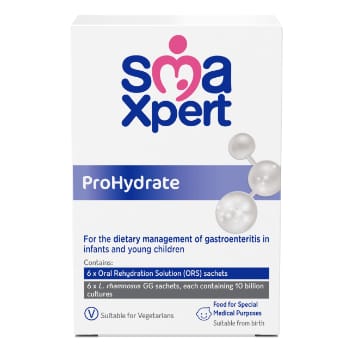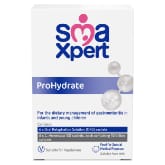SCIENCE INSPIRED BY NATURE
SMA® Xpert ProHydrate
Food for Special Medical Purposes
SMA® Xpert ProHydrate combines an oral rehydration solution (ORS) and L. rhamnosus GG for the dietary management of gastroenteritis in infants and young children.
This product should be used under medical supervision.
Suitable for babies from birth.
Product description

Oral rehydration solution (ORS) contains electrolytes (Sodium, Potassium, Chloride) and carbohydrate (glucose) to support oral rehydration of infants and young children1.
Oral rehydration solution formulated according to ESPGHAN* composition guidelines1
L. rhamnosus GG is associated with a reduced duration of diarrhoea by approximately 20 hours2**
Gastroenteritis is very common, with many children having more than one episode a year3.
Approximately 10% of children younger than 5 years present to healthcare services with gastroenteritis each year4; a UK study found that diarrhoeal illness accounted for 16% of medical presentations to a major paediatric emergency department5.
Most children can be managed at home with oral rehydration therapy, with advice and support from a healthcare professional if necessary. Only those children with severe dehydration require hospital admission3.
NICE guidelines exist for diarrhoea and vomiting caused by gastroenteritis in under 5s who present to a healthcare professional for advice in any setting3.
- In children with gastroenteritis but without clinical dehydration: offer oral rehydration salt (ORS) solution as supplemental fluid to those at increased risk of dehydration3.
- In children with clinical dehydration, including hypernatraemic dehydration: use low-osmolarity ORS solution (240–250 mOsm/l) for oral rehydration therapy3.
There is evidence to support the use of L. rhamnosus GG for the treatment of children with acute gastroenteritis6. For the use of probiotics in the management of children with acute gastroenteritis, L.rhamnosus GG can be recommended at a dose ≥1010 CFU/day, typically for 5–7 days, as an adjunct to oral rehydration therapy7.
Each pack of SMA Xpert ProHydrate contains 6 sachets of an oral rehydration solution and 6 sachets of L. rhamnosus GG, for the dietary management of gastroenteritis in infants and young children.
A daily serving of SMA Xpert ProHydrate contains 10 billion cultures of the L. rhamnosus GG culture.
Suitable for babies from birth to 3 years of age.
Suitable for vegetarians
Data card
Formats

Each box contains 12 sachets comprising of:
6 X Oral Rehydration Solution (ORS) sachets
and
6 X L. rhamnosus GG sachets. Each sachet contains 10 billion cultures.
Supplier code: 12506707
Preparation
Each pack of SMA® Xpert ProHydrate contains 6 sachets of oral rehydration (ORS) solution and 6 sachets of L. rhamnosus GG, which can either be used in combination or as ORS alone, based on Healthcare Professional guidance.
Do not use more than one L. rhamnosus GG sachet a day.
Instruction for use in combination or ORS alone is shown below:
ORS + L. rhamnosus GG sachets when used in combination
-
Always clean your hands before preparing the solution.
-
Tear the sachets along the perforated line. Discard after use.
-
In a sterilised bottle or clean beaker, dissolve the contents of each of the 2 sachets (4.5 g of ORS and 2 g of L. rhamnosus GG) into 200 ml of freshly boiled, cooled tap water. Do not use artificially softened or repeatedly boiled water. Each sachet should be used completely in one use.
-
If not consumed immediately, once prepared, the solution must be kept in a refrigerator and used within 12 hours. When bringing the solution back to room temperature (approx. 20°C) do not heat it up above body temperature (approx. 37°C).
-
Test temperature by shaking a few drops onto the inside of your wrist.
If healthcare professional advice is to use additional ORS sachets, then please see below
ORS sachet when used alone
-
Always clean your hands before preparing the solution.
-
Tear the ORS sachet along the perforated line. Discard after use.
-
In a sterilised bottle or clean beaker, dissolve the contents of one ORS sachet (4.5 g of ORS) into 200 ml of freshly boiled, cooled tap water. Do not use artificially softened or repeatedly boiled water. The sachet should be used completely in one use.
-
If not consumed immediately, once prepared, the solution must be kept in a refrigerator and used within 12 hours. When bringing the solution back to room temperature (approx. 20 °C) do not heat it up above body temperature (approx. 37 °C).
-
Test temperature by shaking a few drops onto the inside of your wrist.
Important feeding information
|
|
Do not use if the sachet is broken or damaged. |
|
|
Do not add extra or less water to make the solution stronger or weaker. |
|
|
Only make the solution with water and to the volume stated. A lesser or greater dilution may result in electrolyte imbalance. |
|
|
We recommend preparing each solution in individual beakers/bottles when required. |
|
|
For hygienic reasons, discard unfinished solution in the beaker/bottle as soon as possible, and always within 1 hour. |
|
|
Do not use more than one L. rhamnosus GG sachet a day. |
|
|
Do not warm the solution in a microwave, hot spots may occur and cause scalding. |
|
Hot water can also kill the L. rhamnosus GG culture. |
|
|
|
Do not add to food. |
|
For Enteral Use Only |
|
-
Booth I, et al. J Pediatr Gastroenterol Nutr. 1992;14:113-5.
-
Szajewska H, et al. Systematic review with meta-analysis: Lactobacillus rhamnosus GG for treating acute gastroenteritis in children - a 2019 update. Aliment Pharmacol Ther. 2019 Jun;49(11):1376-1384.
-
NICE, 2009. Diarrhoea and vomiting caused by gastroenteritis in under 5s: diagnosis and management. Clinical guideline. Available at www.nice.org.uk/guidance/cg84 Accessed January 2022
-
Van Damme P, Giaquinto C, Huet F et al. (2007). Multicenter prospective study of the burden of rotavirus acute gastroenteritis in Europe, 2004-2005: the REVEAL study. Journal of Infectious Diseases.195 Suppl 1:S4–S16.
-
K Armon, T Stephenson, V Gabriel et al. (2001) Determining the common medical presenting problems to an accident and emergency department. Arch Dis Child 84:390–392.
-
Hania Szajewska & Iva Hojsak (2020). Health benefits of Lactobacillus rhamnosus GG and Bifidobacterium animalis subspecies lactis BB-12 in children, Postgraduate Medicine, 132:5, 441-451.
-
Szajewska H, Guarino A, Hojsak I, Indrio F, Kolacek S, Orel R, Salvatore S, Shamir R, van Goudoever JB, Vandenplas Y, Weizman Z, Zalewski BM; Working Group on Probiotics and Prebiotics of the European Society for Paediatric Gastroenterology, Hepatology and Nutrition. Use of Probiotics for the Management of Acute Gastroenteritis in Children: An Update. J Pediatr Gastroenterol Nutr. 2020 Aug;71(2):261-269.
-
Guarino A, et al. Universal Recommendations for the Management of Acute Diarrhea in Nonmalnourished Children. J Pediatr Gastroenterol Nutr. 2018 Nov;67(5):586-593.
-
Guandalini S, et al. J Pediatr Gastroenterol Nutr. 2000 Jan;30(1):54-60.
*European Society for Paediatric Gastroenterology, Hepatology and Nutrition.
**When used in addition to rehydration therapy
IMPORTANT NOTICE:
We believe that breastfeeding is the ideal nutritional start for babies as breast milk provides a balanced diet and protection against illness for a baby. We fully support the World Health Organizations recommendation of exclusive breastfeeding for the first six months of life followed by the introduction of adequate nutritious complementary foods along with sustained breastfeeding up to two years of age. We also recognise that breastfeeding may not be an option due to certain medical conditions. Parents should only feed Infant formula for special medical purposes under supervision of a healthcare professional after full consideration of all feeding options, including breastfeeding. Continued use has to be assessed by the healthcare professional in relation to the baby's progress bearing in mind any social and financial implications for the family. Infant formula should always be prepared, used and stored as instructed on the label in order to avoid risks to a baby’s health. This product must be used under medical supervision. SMA Xpert ProHydrate is intended for the dietary management of gastroenteritis. It is suitable for infants (0-12 months) and children (1-3 years). If the condition does not improve within 24-48 hours of starting SMA Xpert ProHydrate, the family doctor should be consulted. SMA Xpert ProHydrate is not suitable for use as the sole source of nourishment. For Enteral Use Only. Always follow medical advice. For babies, always hold them while feeding and do not leave them unattended as they might choke. It is not a breast milk substitute.


